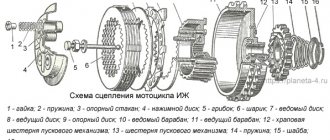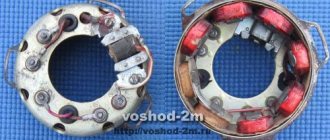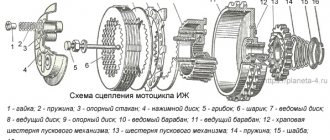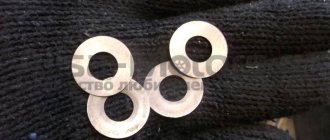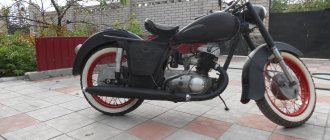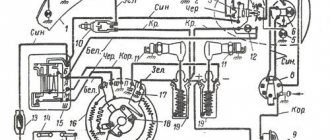"Sores"
“Planet” was good in its time, except for the ill-conceived launch mechanism. For those who have “Planet”, I think there is no need to explain what “return” means. Personally, once it gave so much that it tore the kickstarter shaft in half, bent the gearshift shaft and tore the ratchet on the clutch basket. Those whose slippers fly into the sky are lucky compared to my version...
Clutch adjustment IZ Jupiter
On motorcycles IZH Yu and IZH Yu K, adjustment of the clutch release mechanism begins with the release mechanism, for which the adjusting screw is screwed in all the way and released 1/4 -1/2 turn, after which the lock nut is tightened.
The correct installation is checked by pressing the shift pedal in one direction or another. Moving the front end of the shift pedal 5-5.5 mm from the neutral position should not lead to movement of the pressure plate. After this, the manual release is adjusted using the adjusting screw located in the left post of the clutch lever on the steering wheel (the free play is 5-10 mm).
Checking the clutch drum
The first step is to check the foot start ratchet mechanism. This is where the main load falls. Turn the clutch basket over with the ratchet facing you, remove the retaining ring and disassemble the ratchet.
We inspect the teeth of the ratchet: they should be sharp without chips or other damage. If the teeth are wrinkled or broken, the winding foot will slip 100%. Many suffer from this problem due to thick oil or a weak spring - in fact, the reason for the foot slipping lies in the ratchet.
If the teeth on the basket are not worn out, it is advisable to rivet the ratchet: buy a new one in the store or remove it from another basket and rivet it. I riveted several baskets and they went without any problems until the “victory”...
An example of ideal ratchet teeth.
Often and thickly, the rivets on the ratchet weaken and if you don’t notice this in time, they are cut off. To prevent this trouble from happening to you, move the ratchet with your fingers. If it wobbles, drill out the old rivets and rivet them again. Pulling old rivets usually does nothing.
If you are making a clutch “for yourself” and for a long time, be sure to check the condition of the teeth for the motor chain.
If the teeth have already begun to turn back, then such a basket should be immediately thrown into the trash. It will no longer be of any use: the operating noise will increase, it will 100% eat up the motor chain, and there’s never an hour when one “fine” day it will lick your teeth and you will then be forced to push your jalopy for a long time and tediously...
An example of worn teeth.
It is not uncommon for the basket body to burst. Unfortunately, the body is made of cast iron and welding it will be problematic. If you find cracks on the body, try to find a welder who welds non-ferrous metals, the so-called “argon welder”; they usually take on welding cast iron.
An example of cracks in the basket body. By and large, this basket can still be saved: chamfer the cracks, weld and turn the seams on a lathe. But the teeth under the motor chain were worn out and I threw it away.
Photo report: Repair and assembly of the clutch of the Izh-Planet motorcycle
The clutch of the Izh-Planet motorcycle, no matter what model: be it “Izh-Planet-Sport”, “Izh-Planet 2″ or even Izh-Jupiter” can rightfully be considered a completely reliable and durable unit. But it has its own design flaws, which are a common cause of breakdowns.
Since their first appearance, the Izhey engines, although not as often as we would like, have been modernized. After all, the power of the Planet-5 engine has almost doubled compared to the same Izh-49, and even more so in some models (Izh-Planet-Sport).
The power was increased - that’s good, but the designers didn’t pay enough attention to the clutch. As it was on the Izh-49, it migrated almost unchanged to later Izh models.
This is where the “root” of all problems grows: we increased the engine power - well done! The stroller was attached - even better! The compression has been increased - where would we be without it? But they forgot about the clutch and ratchet mechanism. But the load on it has increased significantly compared to its progenitor - this is where frequent problems arise in its work.
By the way: later Izhey models began to be equipped with a clutch with a reinforced motor chain and an improved design of the kickstarter ratchet mechanism, the so-called “daisy”. Of course, such an “innovation” did not bring much effect: just as the ratchet on the “Planets” tore, it continued to tear. As the motor chain stretched literally in one season, it continued to stretch...
In this article we will look in detail at the main stages of installing and adjusting the clutch. We will also look at common faults and how to repair them.
It is worth noting: The clutch of almost all Soviet-made two-stroke motorcycles is designed according to the same principle, which means that the faults are almost the same - the basis of the design is the same (German DKW). Therefore, everything said in this article can be safely applied not only to Izh motorcycles, but also to others. Whether it’s “Java” or “Minsk” or even “Voskhod”, perhaps the design of the “Ants” has some differences: their kickstarter mechanism interacts with the basket not directly like the others, but through the input shaft of the gearbox. And “Planets-Sport” installed a gear instead of a motor chain, but this does not change the essence, the “sores” of all Soviet motorcycles are practically the same.
Let's start with the basket - this is the weakest part of the entire mechanism, or rather not the basket itself as such, but the kickstarter ratchet mechanism, which constantly breaks. Therefore, before installing the basket on the engine, the ratchet mechanism must be disassembled and checked for functionality.
Take the basket, remove the locking ring, then remove the thrust washer and spring.
We carefully inspect the teeth of the ratchet mechanism; they should not be chipped or cracked and they should be sharp and not licked. If you find the damage described above, do not rush to throw away the basket. The ratchet mechanism can be easily and quickly replaced with a new one.
True, for this, you will need to sharpen the rivets and, of course, you must have skill in such work; if you don’t know how to rivet, then it’s better not to take it on - you’ll ruin the basket! From the outside, riveting may seem like a simple job!
The next step will be to check the reliability of fastening the ratchet to the basket; the rivets securing the ratchet to the basket tend to become loose over time, so it is very important to identify this malfunction in a timely manner.
We take the basket in our hand, try to swing the ratchet with the other hand, if we feel any play, then that’s it! You will have to drill out the broken rivets and install new ones. It is worth warning: simply pulling rivets will not give any effect! Tested many times! Only replacing the rivets with new ones can correct the situation. And it definitely needs to be corrected! Otherwise, sooner or later, the ratchet will break and then, like it or not, you still have to rivet it...
Also, do not forget to pay special attention to the condition of the teeth of the drive sprocket and the basket itself. The teeth must be correctly shaped and not worn out. Unfortunately, there is nothing you can do to help a basket with worn teeth - such a malfunction cannot be “treated.” And finally, we check the basket bearing for acceptable wear; it certainly lasts a long time, but it still wouldn’t hurt to make sure it’s working once again.
A typical example of a basket with heavily worn motor chain teeth. Of course, such a basket will still “use” for some time, but such wear can safely be considered emergency - it is better to replace it.
The body of the “Izhevsk” basket sometimes cracks in the area of the ratchet mechanism rivets; before installation, carefully inspect these places.
The next important step in our work will be adjusting the alignment of the teeth of the basket sprocket and the crankshaft. Everything is simple here: we install a special washer under the crankshaft sprocket (this is described in detail below), put the sprocket on the axle and tighten the bolt with the required force. Next, we put the adjusting washer on the gearbox input shaft, then we put the bushing of our basket there, then the basket itself and from a comfortable position we make sure that the tips of the teeth of the basket and the sprocket are strictly opposite each other. Any deviation is removed by selecting an adjusting washer (we will discuss it later).
Important: Adjustment of the alignment of the sprocket teeth can only be done after final assembly and adjustment of the gearbox.
We begin assembling the clutch mechanism by installing the kickstarter mechanism.
We install the kickstarter shaft support washer on the gear shift mechanism shaft.
We take the kickstarter shaft with our hand, check the condition of its splines and sector teeth, everything should be perfect - there should be no wear or other damage.
When starting the engine, a very high load is placed on the kickstarter shaft and the entire ratchet mechanism as a whole, especially if your ignition timing is incorrectly adjusted. Kickback to the leg when the ignition is incorrectly adjusted often leads to injury or damage to the shaft or ratchet mechanism. Therefore, before installation, you need to pay special attention to the kickstater parts and, if there is any suspicion, replace them with new ones.
The splines of the winding foot should be in this condition
The sector teeth are like this
We put the winding claw on the shaft, insert the end of the return spring into a special groove in the crankcase and tighten the spring a turn or two and drive the shaft all the way into its place. Do not tighten the return spring too much. Pull it so that it does not stick out anywhere and does not interfere with the operation of the kickstarter, and of course returns the foot to its place.
We install a special spring washer on the crankshaft journal and then insert the key into place.
We put a pre-selected adjusting washer on the gearbox input shaft.
We install the clutch basket drum bushing on the gearbox input shaft.
We put the motor chain on the basket and the sprocket, turn the drive sprocket so that during installation the key fits exactly into its groove and put the whole thing on the assembly in one go onto the shafts.
An important point: before installing the sprocket, carefully inspect both cones so that nothing gets on them and wipe them dry with a clean cloth before installation.
We install the inner drum on the shaft.
Place a special washer on the shaft and screw on the central nut.
We weld some kind of rod or piece of tire to the old unnecessary clutch disc - this will be the key for tightening the nut on the drum. We put it on the inner drum, rest the rod against the kickstarter shaft, take the 22mm socket and tighten the central nut (left-hand thread) with the maximum possible force.
We take a tin rod for soldering or some kind of stick, fit it under the teeth of the drive sprocket and tighten the bolt with the maximum possible force. In this engine, the design of the drive sprocket is slightly changed: our engine is not “purely Planetovsky”, but from a motorized stroller, but there is not much difference between them.
After tightening or before unscrewing the central nut and bolt of the drive sprocket, check the condition of the motor chain. We press on it and look at how much it sag: the permissible sag should not exceed two centimeters. We installed an almost new chain on this engine, so the sag as you can see is minimal.
To ensure that your clutch does not slip after assembly and that its discs do not move, you must check for deformation. Usually no one does this: either it’s laziness, or something else... And then I start to twist and turn it, not understanding what’s going on: I seem to have installed new disks and assembled them correctly - adjusted them, but it either drives or slips...
There is nothing complicated here: we take a piece of thick glass or an ordinary mirror, place a disk on it and touch it with a finger on top; if the disk “dances” on the glass, it means it is deformed. Here you need to decide a little: on plastic discs, slight deformation is allowed, over time the discs will heat up and take on a perfectly even shape, but on steel discs there should be no deformation. Change crooked discs without regret, otherwise you will not get normal operation from the clutch.
After checking the discs, you can begin further assembly of the clutch. First, a support disk is placed on the inner drum with a groove facing the basket. You can easily find the support disk in the kit: it is thicker than the others and has the groove described above on the inside.
Then we put in a plastic disk, then a metal one again, and so alternating the disks with each other we collect a complete set. After all this has been done, install the clutch rod (marked with an arrow) into the input shaft of the gearbox. A regular “Planet” basket can accommodate six plastic disks and six metal ones along with the support one. The very last (sixth) you should have is a plastic disk.
But there is a nuance here: “from the factory” the basket is equipped with a seventh metal disc, which is placed between the last plastic and clutch pressure plate, that is, in the last place. This disk is no different from the others, but it is not necessary to install it at all - you can remove it without fear, it has absolutely no use there.
Next, we install the pressure disk, put the pressure spring cups in their places, making sure that the special protrusions on the cups coincide with the recesses on the disk, install the pressure springs and tighten the special nuts so that the ends of the nuts are higher than the ends of the bolts of the inner clutch drum by 4 -5 millimeters.
To prevent the nuts from unscrewing during work, make a notch with a chisel as shown in the photo. From the factory, the nuts are already marked with a notch, but during the process of disassembling and assembling the clutch, it wears out and loses its functions.
The final step in this work will be to check that the clutch pressure plate is working correctly. To do this, we turn the engine over or place it directly on the motorcycle frame, place the ball on the sprocket side in the gearbox input shaft, then place the second clutch rod there and screw on the generator cover. We adjust the clutch, then fully squeeze the lever and watch how the pressure plate moves away. If the disk comes off skewed, then tighten or loosen the nuts a little in the right places and that’s it. Try to adjust the tension of the nuts so that when you press the clutch lever, the disc moves out as smoothly as possible - without distortion.
Checking the clutch basket inner drum
The inner drum is eternal by definition. The only problem that arises with it is that it breaks and sometimes cuts off the splines and the fit of the bolts under the pressure springs becomes loose.
Place the drum on the shaft and swing it:
- If the drum dangles too much on the shaft, inspect the splines and if they are broken, replace the drum with a new one.
Loosen the bolts under the compression spring one by one:
- If the bolts wobble, knock them out of the drum, anchor the seats and hammer them back into the drum.
To watch online, click on the video ⤵
Mokika clutch assembly Carpathians More details
Refinement and adjustment of clutch B 501 Read more
Assembling a clutch with a powerful spring in the field More details
V-50 engine assembly. The finishing touches. More details
How to remove the clutch basket on a Karpaty moped without a puller Read more
Moped CARPATHIANS. Karpatych 3 series. Replacing the clutch basket More details
How to assemble a clutch basket for a Karpaty moped? More details
How to assemble a clutch basket for mopeds: Carpathians, Delta, Verkhovyna. More details
I opened the CLUTCH on the KARPATY MOPED and. More details
Delta V50M. Clutch slips. Clutch repair. More details
Assembling the “Karpaty” clutch Read more
Assembling the clutch for a Karpaty moped Read more
And again about the clutch of the V501M engine Read more
Moped Carpathians, clutch repair Read more
Adjusting the clutch and gearbox of the KARPATY moped. More details
//Clutch repair in Mokika Carpathians// Read more
Grip in the Carpathians. The solution has been found. More details
Source
Checking clutch discs
The main clutch problems occur due to the fault of the discs. If the discs are crooked or worn out, then no amount of even a super couture adjustment will correct the poor performance of the clutch.
Wear is determined visually and only on plastic discs: we inspect the disc and if we find a crack or a broken hook on it, with which it enters the outer drum, or we see that the round protrusions on the working surface have long been worn out, we throw such a disc in the trash.
The curvature of the disks is determined as follows: place all the disks on the glass one by one and try to swing them
- If the disk wobbles, it means it is 100% crooked and should be in the trash.
- If the disk lies flat, leave it.
Engine clutch V-50, V-501M.
mitroxa,
BoNkA , New gears (if you installed a new basket or a different one) can howl until the teeth break in. This is due to errors in the manufacture of gears.
Or also vice versa. The transmission will howl the more the teeth wear out.
It is difficult to determine gear wear by eye, but significant wear can be seen immediately by the profile of the teeth and their working surface.
If the gears are exactly changed (one of a pair or both (it doesn’t matter), then the running-in of the teeth is disrupted and some time must pass before the teeth get used to each other. In this case, the gears should work in a gentle mode. If you give a full load, the risk of tooth breakage increases. As the gears run in, their noise decreases on its own, reaching a certain reasonable limit.
So drive carefully and everything will go away on its own. If you don’t want to, change the gears in pairs from where they already worked.
BoNkA , What do you think is on the basket? Isn't it a gear? Or did you separate the basket from the gear and then weld it again?
I am writing to you that if the gear is not used and the second mating gear is not worn out, then they will make noise until they break in.
